How to Read Linux Files in Windows
Summary :
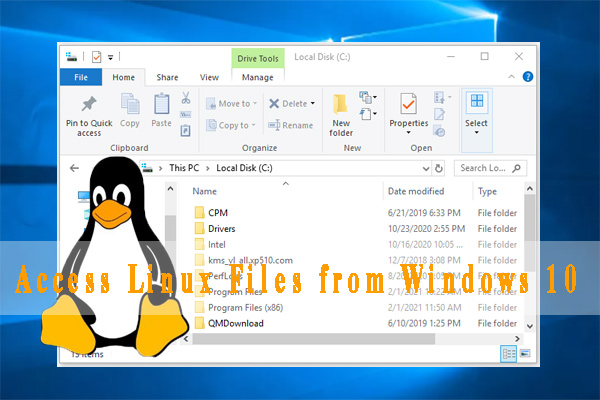
What'south a Linux file organisation? Tin can I read Linux drive on Windows? How to access Linux files from Windows x? A lot of users are dislocated near these questions. In the article, MiniTool will explore them one past ane together with you.
Quick Navigation :
- What's Linux File Organisation
- Can I Access Linux Files from Windows x
- How to Access Linux Files from Windows 10
- What's Your Opinion
- Access Linux Files from Windows 10 FAQ
- User Comments
If you accept a Linux distribution alongside a Windows system on the laptop or desktop, you may need to access Linux files from Windows 10. Later analyzing lots of user reports on forums, we conclude the post-obit questions that are frequently talked about. Allow'south commencement exploring them in item.
What'southward Linux File Organization
In order to access Linux files from Windows successfully, the offset thing you should figure out is what file system is supported by Linux. The mutual Linux Files Systems are Ext2, Ext3, and Ext4.
At nowadays, Ext4 has go the default file system for most Linux distributions including Debian and Ubuntu. This is because the Ext4 provides more flexibility for storing large files than other extended file systems. It's reported that the Ext4 tin support storing a file upward to 16TB and creating a partition upward to 1EB.
Peak recommendation: How to Install Linux (Ubuntu) on Windows 10 [Ultimate Guide 2021]
Can I Access Linux Files from Windows 10
There are a lot of users who have Windows 10 plus Linux dual kick or a hard bulldoze formatted with Ext4. And so, here comes a new question. Can I access Linux files from Windows 10? As discussed in a higher place, the nigh common Linux file system is Ext4. That is to say, you lot have to read Ext4 from Windows if you desire to admission Linux files.
Still, the Ext4 file system is not supported by Windows. When right-clicking the Ext4 segmentation, you lot volition find the Open and other part menus get greyed out. Obviously, you lot tin can't access Ubuntu files from Windows direct. What tin I do if I accept to read Linux drive on Windows? Please continue reading the following part.
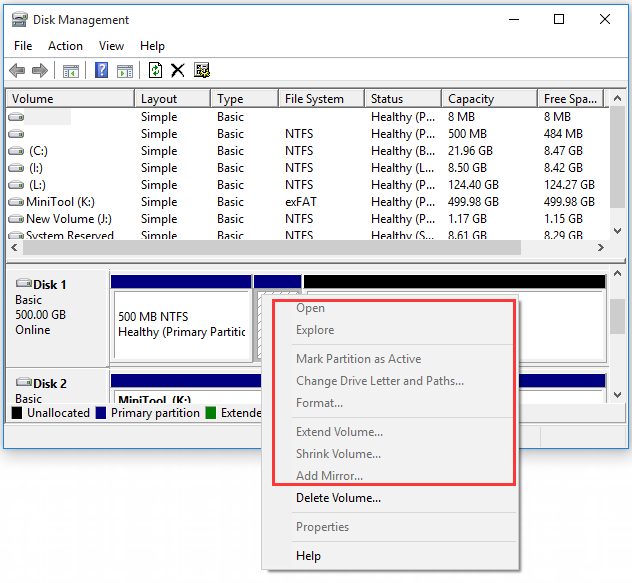
How to Access Linux Files from Windows 10
Since Windows 10 doesn't offer any straight methods to admission Ext4, you lot need to utilise some professional person tools to access Linux files from Windows. Here we summarize top four Ext4 partition readers on Windows.
Method 1. Use Ext4 Segmentation Managing director - MiniTool Partitioning Wizard
MiniTool Sectionalisation Wizard is an all-in-ane sectionalization manager that supports many file systems including FAT16/32, NTFS, exFAT, and Ext2/3/4, Linux Bandy. With this powerful software, you tin can format a hard drive, convert NTFS to Fatty, convert MBR to GPT, recover lost data, migrate OS to SSD/HD, rebuild MBR, and and then forth.
Gratis DownloadPurchase Now
In order to access Ext4 from Windows smoothly, yous can make it accessible past formatting it to NTFS. Although formatting will delete the information on the hard drive, MiniTool can assistance you restore the Ext4 sectionalization data so that yous tin access Linux files from Windows 10.
Office i. Read Linux Bulldoze on Windows
Follow the steps below to format the Ext4 division to NTFS or other file systems that are supported by Windows x.
Step i. Launch the MiniTool Partition Wizard to enter its primary interface, and then correct-click the Ext4 partitioning from the disk map and select Format.
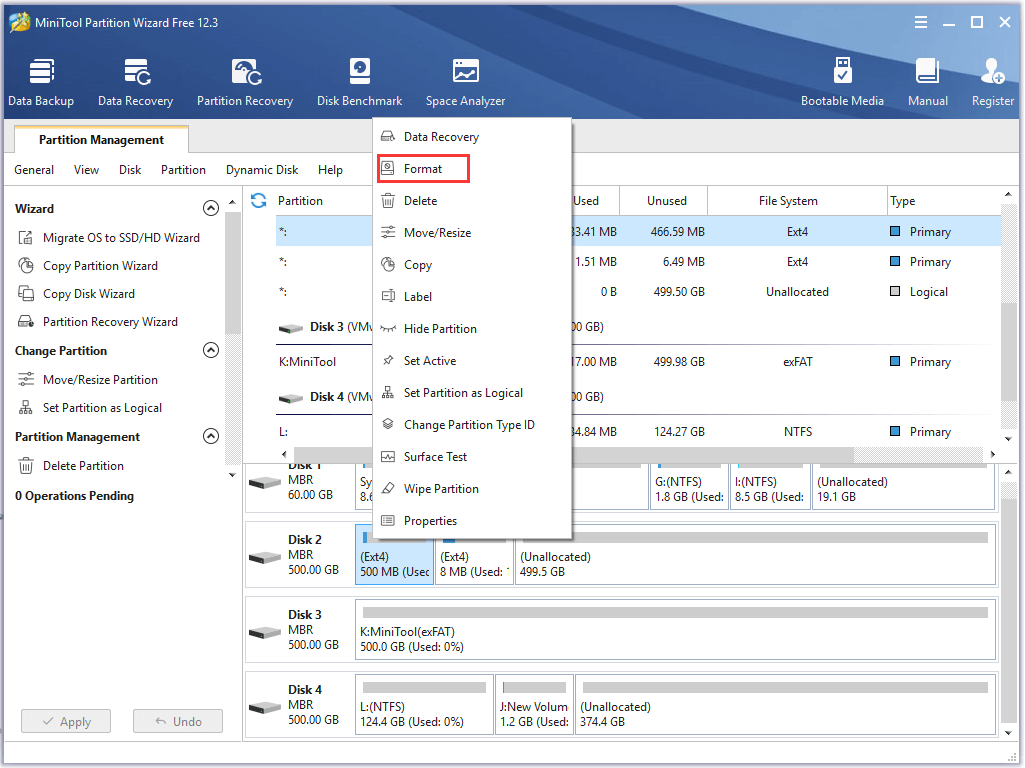
Step ii. In the popular-up window, select NTFS from the drop-downwardly menu and click on OK to continue.
Step three. Click on Utilise button to execute the operation.
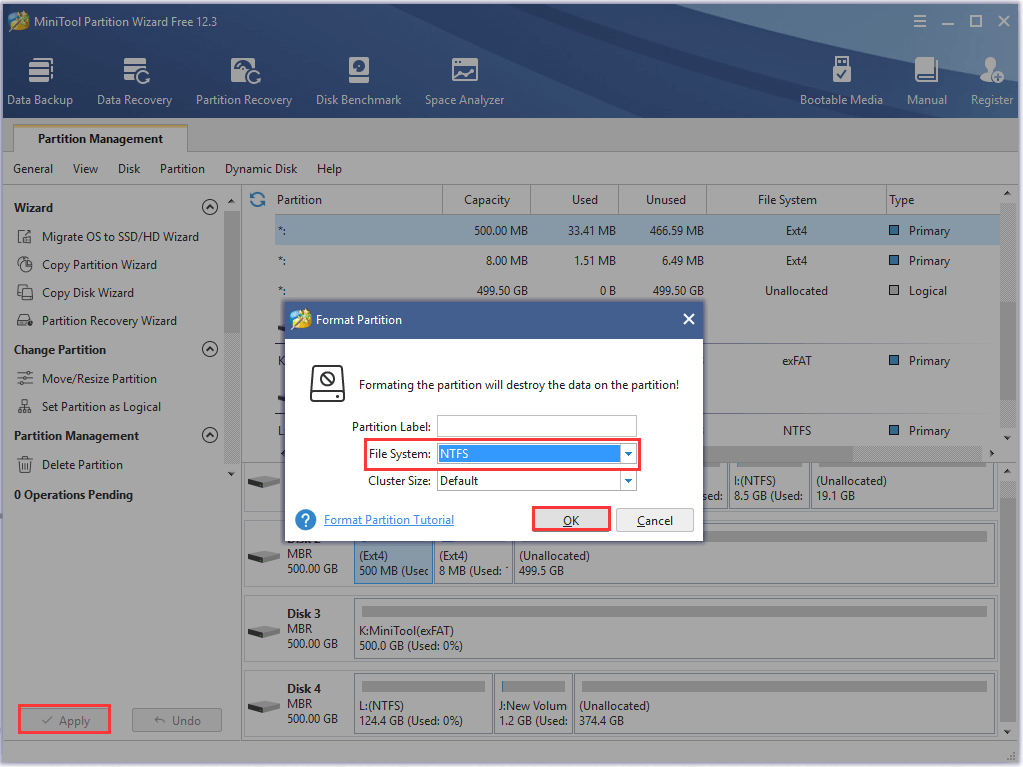
Part 2: Restore Data from the Ext4 Partition
Now, you lot should make the Ext4 accessible on Windows 10. Some other question is how to regain data from the formatted sectionalization. Here MiniTool Division Sorcerer is capable of restoring Ext4 partition data. Please continue with the post-obit steps.
Tip: MiniTool Sectionalisation Wizard Free Edition doesn't support information recovery. You need to install a professional edition or a more avant-garde edition to recover the lost partition.
Buy Now
Step ane.In the master interface, select the segmentation that you lot simply formatted to NTFS and click on Partition Recoveryfrom the top toolbar. Click on Next in the pop-up window.
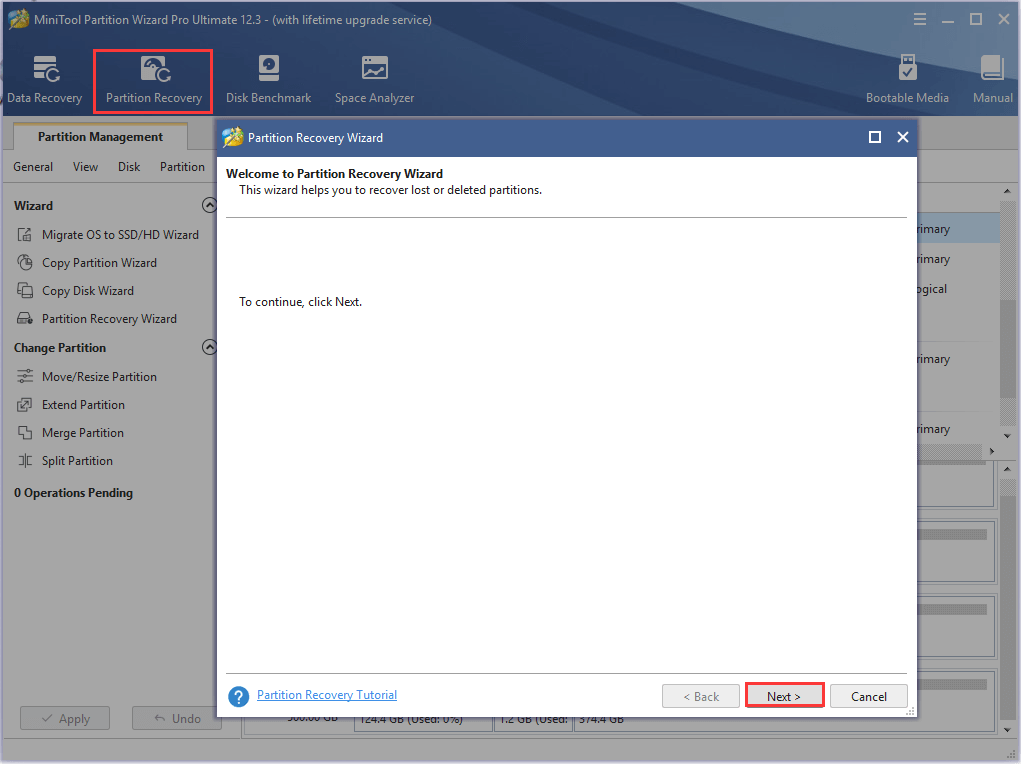
Step two.Choose a scanning range based on your needs. In that location are three ranges to scan the disk includingFull Deejay,Unallocated Space, andSpecified Range. Here we have Full Disk for example and click onNextto go on.
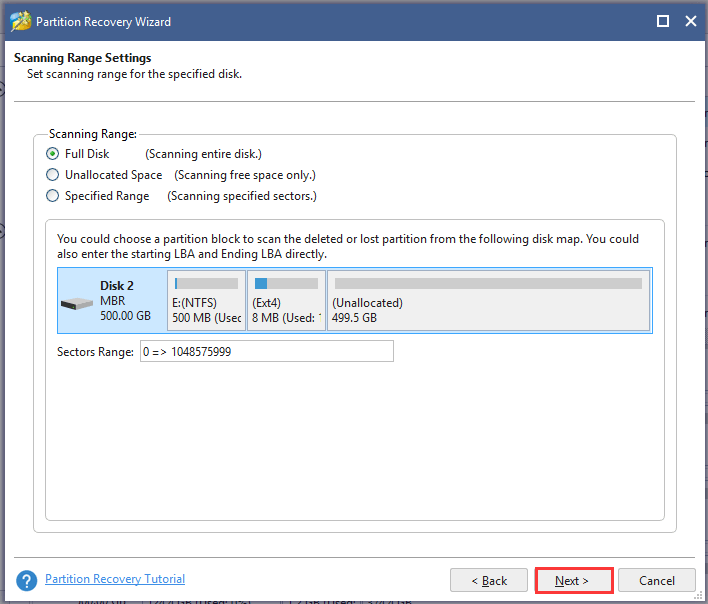
Step 3.Select a scanning method to browse the disk and clickNext to continue.
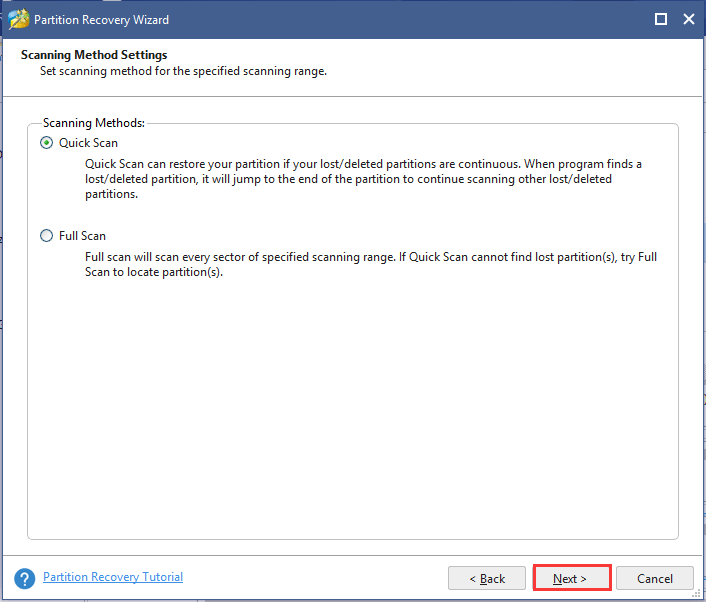
Step iv.Make sure that yous cheque all partitions including existing partitions and deleted/formatted partitions. Wait for some time until the scanning completes and click on theCeasebutton.
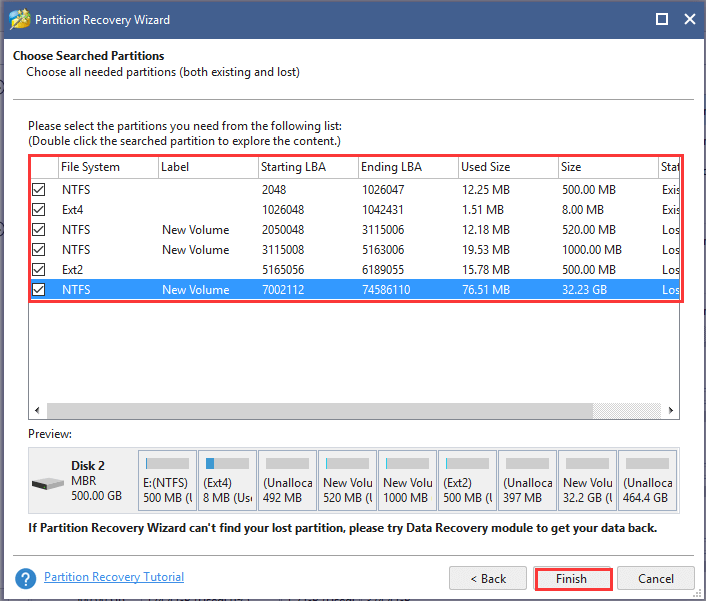
Step v. Click on Use push to recover the formatted partition on the hard disk drive.
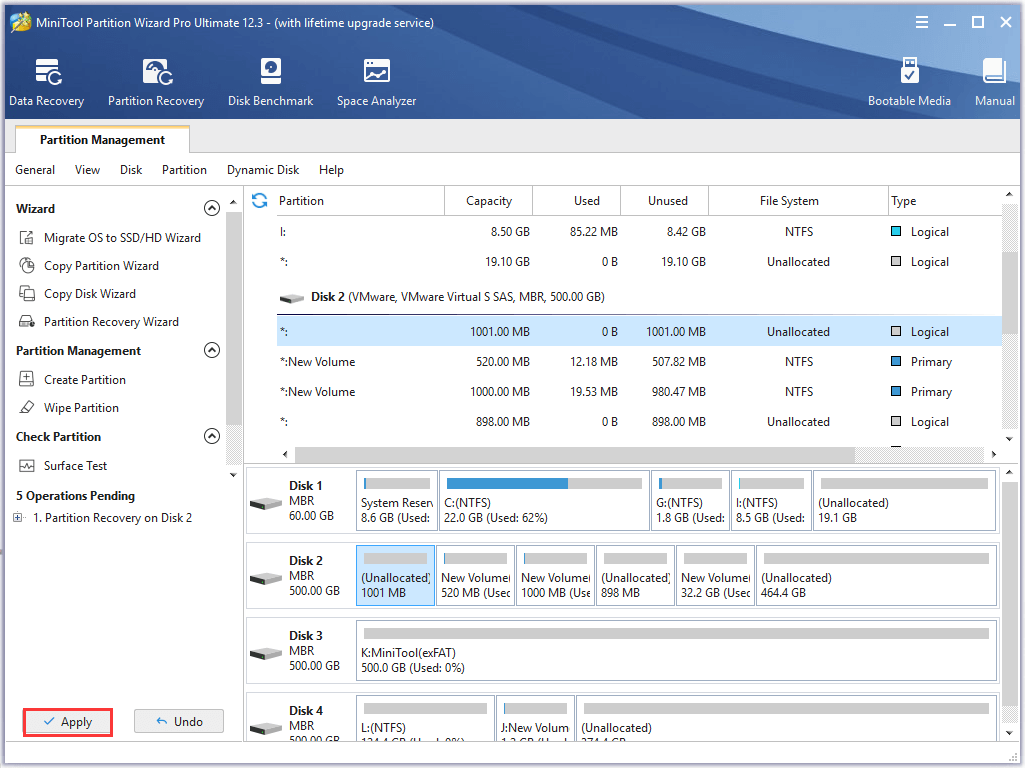
Up till now, the formatted partition should be recovered, and then you can read Linux partition Windows 10 and access its files.
Also, you can endeavor the other 3 utilities to access Ext4 from Windows x. Let's continue reading!
Method 2. Utilize Ext2Fsd
Ext2Fsd is a Windows file organisation commuter that supports the Ext2/3/four file organization. It allows you lot to read Linux sectionalisation Windows 10 and access Ubuntu files by mounting the Ext4 segmentation and assigning a bulldoze letter. Y'all can lunch the Ext2Fsd at every boot or just open it when you need it.
To access Ext4 from Windows, follow the steps below:
Step ane. Install this tool on your Windows 10 PC and launch the commuter.
Note: If you lot don't want to automatically launch the software at every kick, don't tick the checkbox for Brand Ext2Fsd automatically started when system boots.
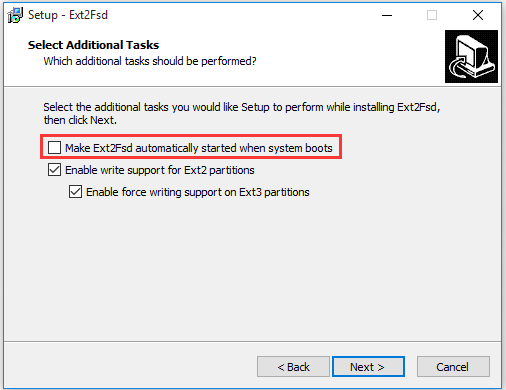
Stride two. In the primary interface of Ext2Fsd, navigate to the Tools tab and select Service Direction from the context carte.
Tip: If you lot haven't prepare Ext2Fsd to automatically outset at boot, you need to select Tools > Service Management > Offset Ext2Fsd service before you access Linux files from Windows ten.
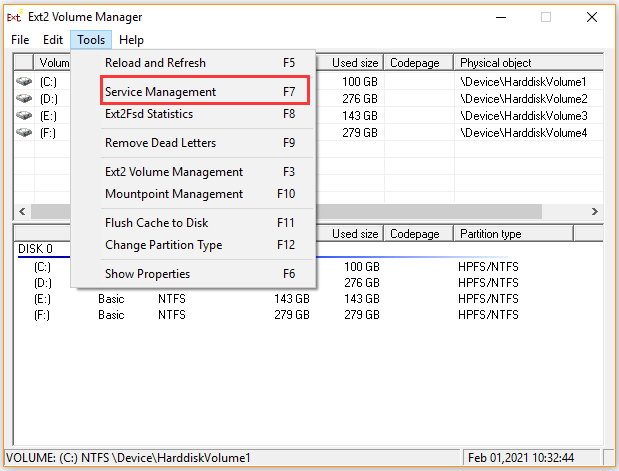
Footstep 3. In the Ext2Fsd Service Management window, select the checkboxes for Mountain all volumes in read-only mode and Assign drive letter automatically. So click on Utilise to execute the operation. Afterward that, this tool will automatically mount and assign drive messages to the Linux partitions.
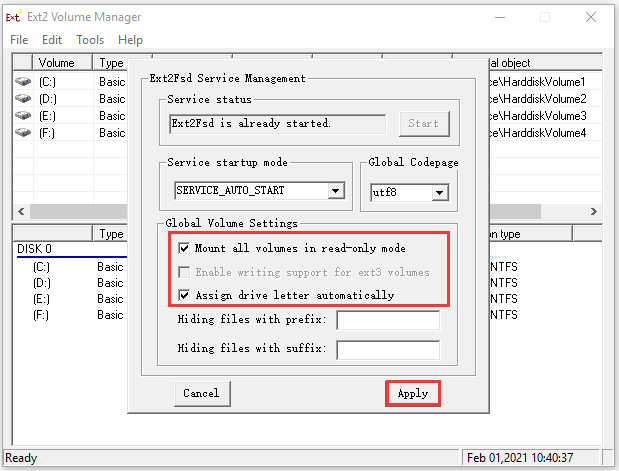
Step 4. Press Win + Eastward keys to open File Explorer, and then yous will notice the Ext4 partitions are mounted with their own drive letters and you lot can directly access Ubuntu files from Windows.
Method iii. Use DiskInternals Linux Reader
DiskInternals Linux Reader is a free utility to access Linux files from Windows 10. This tool can not simply support the Ext4 file system merely ReFS, HFS, and HFS+ file systems. Unlike from Ext2Fsd, this program allows yous to read Linux drive on Windows within this awarding.
Pace 1. Install DiskInternals Linux Reader on your Windows PC and launch it to enter the main interface.
Step 2. After the Linux Reader detects all partitions on your hard drive, navigate to the Ext4 partitioning from the list of drives.
Step 3. Double click the Ext4 segmentation to open up it and so yous tin preview and access the saved information on the drive.
Pace 4. If you want to make full apply of the Linux files on Windows, you have to transfer the files from the Ext4 partition to another location that is supported by the Windows file system. Here right-click the file that yous demand and click on Relieve from the context card.
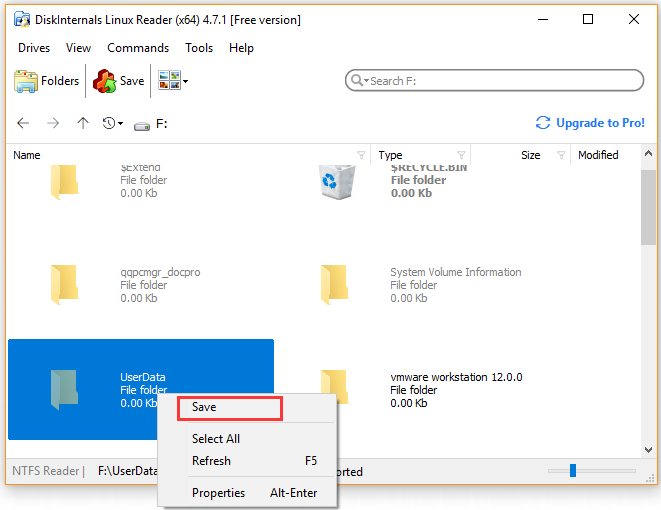
Step 5. Select the Save Files option and click on Next push button.
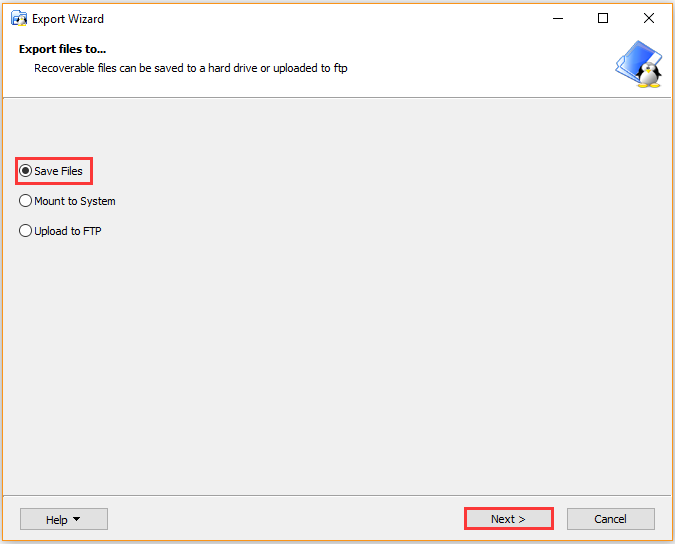
Step half-dozen. Click on Scan button to select a location where you lot save the file and click on OK. So click on Adjacent. Await for some fourth dimension until the file is saved to your selected location.
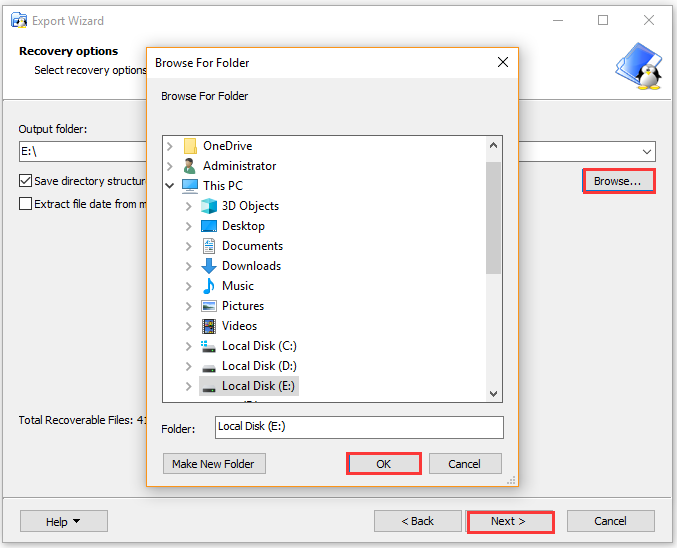
Method 4. Utilize Ext2explore
Ext2explore is a practical explorer that can access Ext2/3/4 files on Windows ten. It works similarly to DiskInternals Linux Reader, merely it doesn't permit you to preview files using Ext2explore. This utility doesn't have to be installed and you tin can run the .exe file straight.
Bear in mind that y'all must run the Ext2explore.exe program equally an ambassador, or yous will receive an error message.
Step 1. Right-click the Ext2explore.exe file that you download to Windows PC and select Run as administrator.
Tip: Also, yous can correct-click the Ext2explore.exe and select Backdrop. Then become to the Compatibility tab and select the checkbox for Run this plan equally an ambassador > OK.
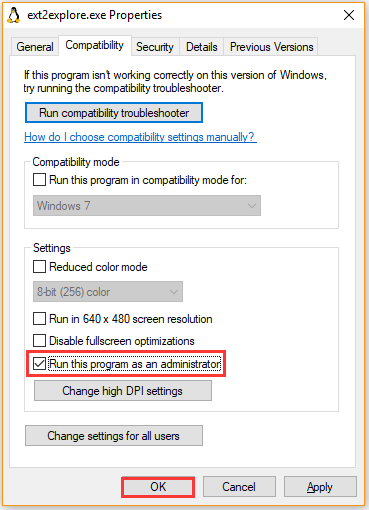
Step 2. Now, you can access the Ext4 division and its Linux files. To open the files in the Windows system, you need to salve them to the Windows sectionalization. Right-click on the file and select Save, then navigate to another location to save files on the Windows system.
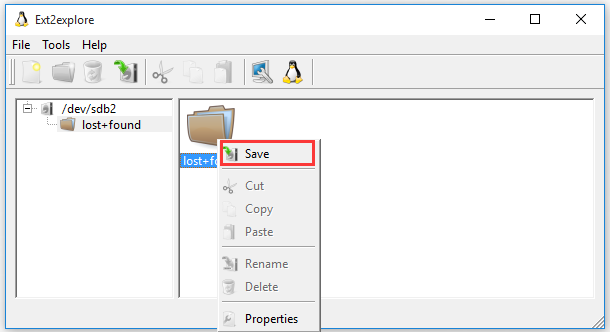
I have Windows x and Linux a dual boot arrangement. Although Linux distribution has built-in support for Windows NTFS sectionalisation, Windows tin can't read Linux bulldoze. Fortunately, I found iv effective methods to access Linux files from Windows ten. Probably you also need this mail. Click to tweet
What'southward Your Opinion
This mail service mainly focuses on how to admission Linux files from Windows 10. You lot can choose i from the top 4 utilities to access Ext4 from Windows. If you take whatever better ideas on this topic, please share them in the comment area. Too, you can send us an email via [email protected] if you have any questions nigh the MiniTool software.
Access Linux Files from Windows ten FAQ
How to transfer files from Windows to Linux?
After analyzing lots of user reports and references, we summarize the following 5 methods to transfer files betwixt Windows and Linux.
- Apply the Share network folders.
- Transfer files from Windows to Linux via FTP.
- Deeply copy the files or folders to Linux via SSH.
- Share the files via sync software.
- Use the shared folder in Linux virtual auto.
How to mountain a Linux folder in Windows?
Here are detailed steps to mount a Linux folder in Windows.
- Printing Win + Eastward keys to open up the File Explorer, and so map your Linux home folder or directory on Windows.
- Click on Tools at the top menu and select Map network drive.
- Select the drive letter from the drop-down menu and click on Browse to select the binder that y'all want to mount.
- Click on Terminate
How to access a network drive in Linux?
- Open a final on your Linux, and then typesudo apt-become install smbfs in it and hit Enter.
- Blazon thesudo yum install cifs-utils line in terminal and printing Enter.
- Execute the sudo chmod u+s /sbin/mountain.cifs /sbin/umount.cifs
- Use the cifs utility to map a network drive to storage.
How to admission a shared folder in Linux?
The first and simplest method is to press Alt + F2 keys to open the Run dialog box, and then blazon smb:// followed by the IP address of your Linux sever and the folder name. Then click on theRun button.
Source: https://www.minitool.com/partition-disk/access-linux-files-from-win10.html
0 Response to "How to Read Linux Files in Windows"
Post a Comment